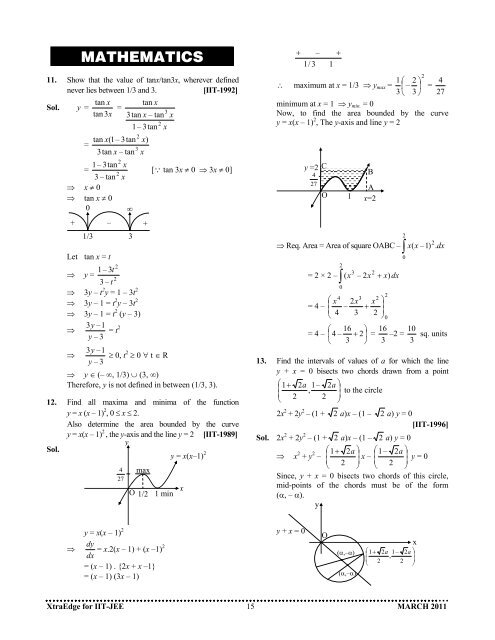March 2011 - Career Point
March 2011 - Career Point
March 2011 - Career Point
You also want an ePaper? Increase the reach of your titles
YUMPU automatically turns print PDFs into web optimized ePapers that Google loves.
MATHEMATICS<br />
11. Show that the value of tanx/tan3x, wherever defined<br />
never lies between 1/3 and 3.<br />
[IIT-1992]<br />
tan x tan x<br />
Sol. y = =<br />
3<br />
tan 3x<br />
3tan x – tan x<br />
=<br />
tan x(1– 3tan<br />
3tan x – tan<br />
1– 3tan x<br />
=<br />
2<br />
3 – tan x<br />
⇒ x ≠ 0<br />
⇒ tan x ≠ 0<br />
0 ∞<br />
2<br />
1– 3tan<br />
2<br />
3<br />
x)<br />
+ – +<br />
1/3 3<br />
Let tan x = t<br />
2<br />
1– 3t<br />
⇒ y =<br />
2<br />
3 – t<br />
⇒ 3y – t 2 y = 1 – 3t 2<br />
⇒ 3y – 1 = t 2 y – 3t 2<br />
⇒ 3y – 1 = t 2 (y – 3)<br />
3y<br />
–1<br />
⇒ = t 2<br />
y – 3<br />
x<br />
2<br />
x<br />
[Q tan 3x ≠ 0 ⇒ 3x ≠ 0]<br />
3y<br />
–1<br />
⇒ ≥ 0, t 2 ≥ 0 ∀ t ∈ R<br />
y – 3<br />
⇒ y ∈ (– ∞, 1/3) ∪ (3, ∞)<br />
Therefore, y is not defined in between (1/3, 3).<br />
12. Find all maxima and minima of the function<br />
y = x (x – 1) 2 , 0 ≤ x ≤ 2.<br />
Also determine the area bounded by the curve<br />
y = x(x – 1) 2 , the y-axis and the line y = 2 [IIT-1989]<br />
y<br />
Sol.<br />
y = x(x–1) 2<br />
4<br />
27<br />
max<br />
O 1/2<br />
1 min<br />
x<br />
+ – +<br />
1/ 3 1<br />
1 ⎛ 2 ⎞ 4<br />
∴ maximum at x = 1/3 ⇒ y max = ⎜ – ⎟ =<br />
3 ⎝ 3 ⎠ 27<br />
minimum at x = 1 ⇒ y min. = 0<br />
Now, to find the area bounded by the curve<br />
y = x(x – 1) 2 , The y-axis and line y = 2<br />
y =2 C<br />
4<br />
27<br />
O<br />
1<br />
B<br />
A<br />
x=2<br />
2<br />
⇒ Req. Area = Area of square OABC –<br />
∫<br />
0<br />
2<br />
= 2 × 2 –<br />
∫<br />
( x – 2x<br />
+ x)<br />
dx<br />
0<br />
⎛<br />
4 3 2<br />
2<br />
= 4 – –<br />
4 3 2 ⎟ ⎞<br />
⎜<br />
x x<br />
+ x<br />
⎝<br />
⎠<br />
3<br />
2<br />
2<br />
0<br />
2<br />
x ( x –1) 2 . dx<br />
⎛ 16 ⎞ 16 10<br />
= 4 – ⎜4 – + 2⎟ = –2 = sq. units<br />
⎝ 3 ⎠ 3 3<br />
13. Find the intervals of values of a for which the line<br />
y + x = 0 bisects two chords drawn from a point<br />
⎛ ⎞<br />
⎜<br />
1+<br />
2a<br />
1– 2a<br />
, ⎟ to the circle<br />
⎝ 2 2 ⎠<br />
2x 2 + 2y 2 – (1 + 2 a)x – (1 – 2 a) y = 0<br />
[IIT-1996]<br />
Sol. 2x 2 + 2y 2 – (1 + 2 a)x – (1 – 2 a) y = 0<br />
⇒<br />
⎛ ⎞<br />
x 2 + y 2 – ⎜<br />
1+<br />
2a ⎛<br />
⎟ x – ⎝ 2<br />
⎟ ⎞<br />
⎜<br />
1–<br />
2a<br />
y = 0<br />
⎠ ⎝ 2 ⎠<br />
Since, y + x = 0 bisects two chords of this circle,<br />
mid-points of the chords must be of the form<br />
(α, – α).<br />
y<br />
⇒<br />
y = x(x – 1) 2<br />
dy = x.2(x – 1) + (x –1)<br />
2<br />
dx<br />
= (x – 1) . {2x + x –1}<br />
= (x – 1) (3x – 1)<br />
y + x = 0<br />
O<br />
(α,–α)<br />
(α,–α)<br />
x<br />
⎛ ⎞<br />
⎜<br />
1+<br />
2a<br />
1 – 2a<br />
, ⎟<br />
⎝ 2 2 ⎠<br />
XtraEdge for IIT-JEE 15 MARCH <strong>2011</strong>

















